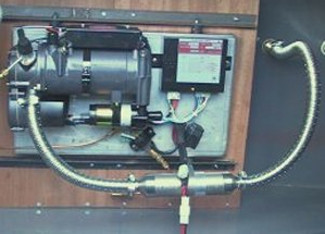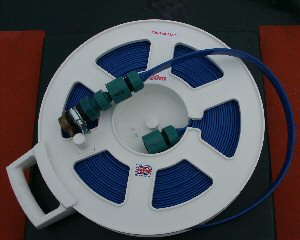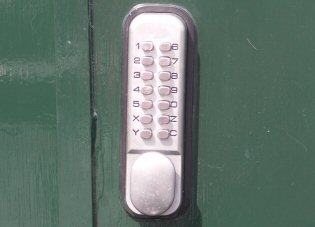Victor on our equipment
Article Index
LET'S break the trend this week and concentrate on equipment for our boats, giving you our own experience of the equipment we have used and how it fared.
It all depends on usage of the boat of course, but in our case we use it every week with a night and a day, come hail or high water, and two fortnight cruises at the beginning and end of the boating season, calculating around 72 days a year, as of course there are weeks when a visit is not possible.
Heating
Being the middle of winter I'll start with a rather important subject—heating. Though many of you boaters rely on a solid fuel stove for heating, there are many who prefer a few hot water radiators, either coupled to the stove, or more efficiently powered by a diesel heater.
 We have had experience of two diesel heaters in our two boats, an Eberspächer Hydronic in the first one but a Mikuni MX40 (pictured) in our present narrowboat. With a very good reason for the change—the Eberspächer needed two major, and costly, repairs in its first three years and was totally unreliable, often failing to start even with fully charged batteries and though only driving three radiators and heating water.
We have had experience of two diesel heaters in our two boats, an Eberspächer Hydronic in the first one but a Mikuni MX40 (pictured) in our present narrowboat. With a very good reason for the change—the Eberspächer needed two major, and costly, repairs in its first three years and was totally unreliable, often failing to start even with fully charged batteries and though only driving three radiators and heating water.
We had had enough, so it was a Mikuni for our present boat that has had one repair that wasn't costly, and just three services over its 14 years with the last one requiring a cracked combustion chamber needing replacing. It has been most reliable driving four radiators and heating hot water, and costing nowhere near as much in repairs as the Eberspächer.
A great advantage of the Mikuni is that all its components are accessible, plus it has a system of lights that shows if a problem occurs and what the problem is, whereas the Eberspächer is packed into a steel casing and had no warning system whatsoever when it stopped.
Power
Inverters are of course a must in a narrowboat when needing mains power if away from a mains hook-up.
We have found them very useful for various things, and find a 300 watts model for say an electric blanket and 'light' electricals such as a television, DVD etc and charging tablets and mobiles is quite sufficient, as we don't use high power equipment such as a microwave.
 Over the 20 years or so we have experimented with many, but by far the worse was a rather expensive 300 watts Victron Energy that would not drive a pre-digital television properly, but only with strange colours (pictured). A much cheaper replacement 300 watts did it fine and is still in use many years later.
Over the 20 years or so we have experimented with many, but by far the worse was a rather expensive 300 watts Victron Energy that would not drive a pre-digital television properly, but only with strange colours (pictured). A much cheaper replacement 300 watts did it fine and is still in use many years later.
The television was less than 100 watts. It rather put me off that company's product, especially after learning from another boater that his rather expensive Victron Energy set-up kept having to go back to his boat builder for attention.
Recording
Using the boat weekly, and none of us being drinkers we tend to watch television come the evenings, and not wanting to be stuck with what is being offered, we brought recorded programs from home to entertain us.
In the days of video recorders and players this was no problem, but certainly was at the demise of this medium, resulting in our recording on a hard disk machine then transferring it to the boat for the cruises. But you will of course see the problem—it was just too much hassle moving the equipment every week from home and reinstalling it in the boat should we wish to view a series.
 So to Amazon to discover a £14 Digital Terrestrial Receiver that records onto a tiny SD card or USB stick! The solution, with one at home and another on the boat.
So to Amazon to discover a £14 Digital Terrestrial Receiver that records onto a tiny SD card or USB stick! The solution, with one at home and another on the boat.
But what a performance to get it to work, my Chinese not being up go scratch. After a few failures perseverance had the better of it, helped by more instructions in English from the supplier. So another 14 quid was spent for one for the boat, and hey! presto! we are in business.
Simply recording at home onto a SD card, taking the card to the boat and playing, with no loss in quality—problem solved.
Should you be interested simply search for a DV3 T. But it is not straight forward be warned! The recording process is weird and wonderful, but can be mastered!
Steer clear of satellite
Whilst television is the subject, now to aerials. If you are in the position where you are fitting, my advice is steer clear of a satellite system—should you actually want to see anything!
In the old days of terrestrial television we tried satellite for a year, and what a performance it was too. I well remember a trip to the western end of the Trent & Mersey and managing nicely to lock onto that speck in the sky, then after a couple of days the boat must have been tipped to one side as we lost alignment. Two and a quarter hours struggle and still no picture. And yes we had a meter and a compass to supposedly make it as easy as possible.
Then on though Manchester along the Ashton and Peak Forest canals and back along the Macclesfield we had more days without as with. Alteration of the boat caused by using water or the filling of a waste tank or even stacking shopping on one side, and you have lost the picture. And when moored, satellite is still a problem, which is why you see so many moored boats with adjustable straps holding it firm against the bank to stop passing craft moving it, and so loosing the picture.
 Luckily digital came along, and a decent aerial solved the problem with Freeview. Mind you, if you must have sport and Sky, there is little you can do about it.
Luckily digital came along, and a decent aerial solved the problem with Freeview. Mind you, if you must have sport and Sky, there is little you can do about it.
Not very good
Mind you with digital, size really does matter—the larger the aerial the better, as now seen by the plethora of masts on boat roofs, and ours in the picture above, which can be stored whilst cruising in the empty bow deck, guarantees a picture wherever we go.
A couple of years back Thomas was sent a small aerial for review, taking it with us on a trip to give it a decent test, but alas it failed miserably on our Huddersfield Narrow cruise, managing to work less than half the time. Okay we were in the hills, but the transmitter could often be seen, and our normal aerial worked all the time...
 He told the fella, but was 'kind' and did not give a review, though I thought he should to warn prospective buyers. But I shall—here's a picture of all 16 inches of it, and I admit some must have been sold as they are seen on boats, but I always wonder how they fare? The aerial was a bit of use as we wanted small lengths of wire, so cut a couple of pieces off, hence the missing lengths in the picture!
He told the fella, but was 'kind' and did not give a review, though I thought he should to warn prospective buyers. But I shall—here's a picture of all 16 inches of it, and I admit some must have been sold as they are seen on boats, but I always wonder how they fare? The aerial was a bit of use as we wanted small lengths of wire, so cut a couple of pieces off, hence the missing lengths in the picture!
Lighting
Lighting is often a problem on narrowboats, and many, like us, plumbed for the square florescent 20 watts lights, which are fairly useless if a fairly bright light is desired.
So with the influx of the brighter halogen lighting plus the added benefit of the same output at less wattage, we purchased the round chromium lights with the G4 halogen bulb.
 A visit to Midland Chandlers at Mercia for various spares had us buying a couple of spare bulbs, which I thought rather expensive at £4.50 each. After a couple of years use the bulbs started giving up the ghost, but by this time, like I should imagine, many other boaters we were well into Amazon, so searched for G4 bulbs, eventually buying 10—yes 10—for the post paid price of exactly £4.49! Exactly ten times cheaper than Midland Chandlers! The phase 'ripped-off' springs to mind.
A visit to Midland Chandlers at Mercia for various spares had us buying a couple of spare bulbs, which I thought rather expensive at £4.50 each. After a couple of years use the bulbs started giving up the ghost, but by this time, like I should imagine, many other boaters we were well into Amazon, so searched for G4 bulbs, eventually buying 10—yes 10—for the post paid price of exactly £4.49! Exactly ten times cheaper than Midland Chandlers! The phase 'ripped-off' springs to mind.
Here's a picture of the bulbs and the invoice. And you may possibly notice they are the much brighter 20 watts. And the extra wattage gives us much brighter lighting.
Should you have the same lights and want to save yourself a packet on bulbs just search Amazon for G4 bulbs.
Dangerous
I am often amazed at not only boaters, but marina operators and hire companies too that use garden hose to supply water to boats, yet it is well known that the bits of plastic that break off from the inner lining of the hose is considered to cause cancer!
 Yes, those bits of black plastic floating about in your kettle is doing you no good whatsoever, and could even be killing you!
Yes, those bits of black plastic floating about in your kettle is doing you no good whatsoever, and could even be killing you!
We use the flat blue hose on a reel, marked 'For food use', as it has no dangerous lining, and my advice is if you are using garden hose to fill your boat's water tank, get rid of it, that is if you are concerned about your health and that of any others that may share your boat.
Convenient
And now for just about the handiest item we have on our boat—a numbered keypad lock on the door.
 Surely I don't need to remind you who have had problems with misplacing keys about the hassle it brings, something we never experience, just a few clicks and we are in, and no keys to lose!
Surely I don't need to remind you who have had problems with misplacing keys about the hassle it brings, something we never experience, just a few clicks and we are in, and no keys to lose!
It was fitted by Simon Piper who built the boat, but it would be easy to fit and be much safer than the normal hasp and lock that can easily be broken, and well favoured by burglars, as some of you will well know. We purchased it from that very handy ironmongers at Rugeley on the Trent & Mersey.
Getting on line
I will end this little venture into our equipment by telling you of our method of obtaining Wi-Fi, a method that very rarely fails.
 It is a dongle provided by Three, and allows up to five separate items to be connected at the same time wirelesly, and it works. Hung in the window it shows the strength of reception, so it is easy to ascertain which side of the boat is best. On our last trip down the Oxford and back, we obtained a signal every day, without fail, allowing me to keep you informed. We even use it at our mooring at Sawley as its new Wi-Fi service just does not reach us.
It is a dongle provided by Three, and allows up to five separate items to be connected at the same time wirelesly, and it works. Hung in the window it shows the strength of reception, so it is easy to ascertain which side of the boat is best. On our last trip down the Oxford and back, we obtained a signal every day, without fail, allowing me to keep you informed. We even use it at our mooring at Sawley as its new Wi-Fi service just does not reach us.
So that is it my friends, a resume of the equipment, purchased, used and occasionally discarded. I hope you have found it useful. And remember our esteemed editor is always pleased to receive your own comments on any equipment—good, bad or indifferent...
Victor Swift
